Several observations about Australia:
--It is very big: about the size of the continental U.S. Thus it is impossible to cover even in six weeks;
--It is very far away: So it takes a long time to get there. We flew NY-Los Angeles (6+ hours), then picked up a flight to Melbourne (some 15 more hours). This is the longest non-stop in the Qantas repertoire--about 8000 miles. Thanks to the international dateline, it takes two days to get there, but no days at all to return.
--It is full of wildlife and sea creatures. These include kangaroos, wallabies, koala bears. All the cute folks you know about. But also snakes to avoid, like the Death Adder and the Taipan (worst of all). And crocodiles and “the world’s most dangerous creature,” the box jellyfish. Their tentacles (extremely venomous) can be ten feet long.
--It is very expensive, and I don’t mean only the air fare. Like many other currencies, the Australian has appreciated substantially against the dollar. An Australian dollar costs 90% of an American. When you figure fees and exchange rates, the two are on a virtual parity. (All prices in this narrative are in Australian dollars, taxes included.)
--Great swimming pools abound.
--Lots of local beer and wine.
--It is composed of a number of states, whose culture varies a good deal. More than 90% of the population lives by the sea. The center is almost empty. The Northern Territory is 3 times the size of California but has little more than half a million, the majority of whom live in its one city, Darwin.
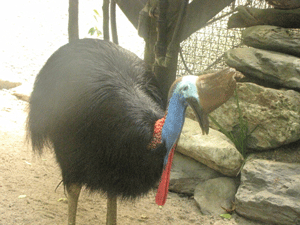
MELBOURNE
Population 3.5 million, it is the country’s second city. According to one survey, it is the world’s 3rd most-livable, behind Vancouver and Vienna. We spent our three days at the Travelodge South. Like the other hotels we stayed in, it was perfectly comfortable and quite without character. The location was ideal, close to the Yarra River, which runs through the city. Many museums and art galleries were an easy walk away. So is Federation Square, the reconstructed modernist heart of the place. There is no subway, but an excellent network of trams and buses. Traffic is light for a city of this size. Do bear in mind that like Brits, New Zealanders, Indians, et. al., Aussies drive on the incorrect (left) side of the road. All is otherwise normal, except that turning right over the tram tracks requires a “hook turn” which first pushes you leftwards. Confusing, but better than colliding with a tram.
We missed the enticing theatre, but spent an evening with an indigenous (though in appearance quite white) woman and her darker assistant. We had dinner at their restaurant, Tjanabi, in Federation Square. We had our first and last taste of kangaroo, which isn’t bad if you are an enthusiastic carnivore.
THE GRAMPIANS
For the first of four occasions, we picked up a rental car. We headed west to the Grampians (mountains) 150 miles away. It was easy going once we found our way out of the city. Traffic was sparse, and signs urged you to stay alert: “Only sleep cures fatigue”; “Feeling drowsy? Take a powernap.” We stayed awake all the way to our destination, the resort village of Halls Gap. It was the weekend site of a jazz festival, which made it more crowded than usual. The Anglican Church had a “jazz mass” Sunday morning. We stayed at one of the four brick Heatherlie Cottages. It was very comfortable and saved us from a lot of pricey restaurant meals. We had brought some food from Melbourne, which we supplemented from the local “overpriced and under stocked” supermarket. A hunk of Jarlsburg and a pack of TimTams (irresistible chocolate crackers) was $16.50. Thus equipped, we made the 5-hour “Wonderland Walk” in the lush forested hills just west of the village. It is moderately uphill, with great views in the higher sections. There were some appealing sandstone cliffs, but no one climbing on them.
The best known place for climbing in Australia is Mt. Arapiles, which was only a couple of hours’ drive away. (Non-climbers may wish to omit the rest of this paragraph.) It is a big sprawl of orange rock rising from flat dry ground. The number of routes is variously claimed as 1200 to 3000. There is almost no vegetation. Also very little fixed gear: this is strictly a trad area. It’s climbable year-round, though spring and autumn are best. We hit a warm mid-summer day, and there was surprisingly little action. The only rope we encountered was a young couple from Colorado simul-climbing a moderate. The rock is very solid sandstone--exceedingly tempting. Bring a full rack.
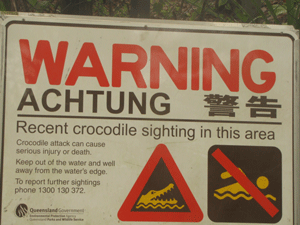
TASMANIA
It’s an hour flight from Melbourne to the island’s biggest city, Hobart (200,000). (The whole island has only half a million.) Like almost all other population centers in the country, it has an active and attractive waterfront. We had a day to walk around before driving up the east coast to Tasmania’s second city, Launceston, half the size of Hobart. It’s a beautiful ride. We regretted having only a few hours for the Freycinet Peninsula, a national park with lots of trails and beach.
Launceston was our assembly point for the Cradle Mountain guided walk. This we anticipated with a mixture of enthusiasm and apprehension. The terrain was said to be glorious and the altitude very moderate, but we would be bearing packs in excess of 20 pounds--not much if you are reasonably young, but we are not. I was somewhat reassured to find that one of the participants looked as old as I. (She turned out to be one of the strongest hikers, however.) We were in all 10 clients and two guides. The other clients were all Aussies, three couples and two women. One of the couples was Jewish, which made us feel culturally at home.
We were picked up at 6:15 for the long drive to the Cradle Mountain National Park. Along the way we stopped to collect our Tassie guides, Adrian (male, 31) and Ciora (female, 23). We also surrendered our worldly possessions, except for what we could stuff in the packs that we knew we must carry for six days. We started walking at 11:00 that morning. I soon found myself trailing the pack, but was sure that could not last long. In fact it lasted all the (rather long) day. The trail was well maintained but had a persistent upward tendency. The more I removed from the pack (like lunch), the heavier it got. The view was, as promised, magnificent. I looked at it whenever I could take time off from breathing hard. We stopped at a beautiful but chilly lake where some us (Susan, yes; me, no) took a dip. Soon Cradle Mountain loomed above us. It is a Nunatak--that is, not covered by the ice age glaciers around it. Orange and craggy, it is often veiled behind the frequent Tassie clouds. The rock looked poor for rock climbing, but I didn’t rush up to check. We had gained most of our altitude now, but the hut where we were to spend the night remained elusive. We finally reached it at 5:30. Well, that’s when I got there; the others had already arrived, perhaps wondering, whether I could really last six days. As was I.
There are two kinds of hut in the park. The public ones are very bare, just platforms and minimal cooking facilities. But they are free and have a roof. They are for the young and hardy who are ready to tote a pack heavy with sleeping bag, food, and a tent in case the hut is full. We chose instead the private, expensive and in part luxurious alternative. On arrival at your hut, you find fresh bread or muffins made by one of the guides, who has run ahead with a weighty pack. Also a welcomed cranberry-like juice. And you can repair to your room for a rest. The quarters are the size of a small ship cabin, but adequate, and with lights. Supper, expertly prepared by the guides, is ready around 7:30. The first night began with mushroom soup, followed by lentil and sausage. Apple crumble for dessert. There was a bottle of wine for each couple. Some found this insufficient. You know those Aussies.
The five private huts along the route are almost identical. They have just five small double rooms for clients, so you can be sure the group will not be large. The living/dining room is large and comfortable, with great views. There are two showers and two toilets. The latter, like everything else we saw in the country, are designed for minimal environmental impact. Twice a year the contents receive “a first-class helicopter ride” out of the park.
The following five days were gentler than the first, and I was able to edge out of last place at times. The notoriously unstable Tassie weather behaved nicely on all days but one: moderate temperatures, intermittent clouds. Unfortunately, the one exception was the day of our assault on the on the highest peak in Tasmania, Mt. Ossa (yes, there is a Mt. Pelion as well). I would not overstate the difficulties. The top is only 5300 feet, just short of Mount Marcy, highest in New York State. You don’t need a rope; the route is quite distinct. Nevertheless this big square mass of dolorite looks very intimidating as you start up. The trail becomes a succession of steep switchbacks, followed by bouldery scrambling. Then you descend into a rock saddle before reaching the top. The view is said to be terrific. We wouldn’t know. All we could see were one another and a lot of enveloping cloud. What had begin as rain had turned into hail. (This was not Susan’s favorite moment.) Only six of us clients made this side trip (no packs); the rest were sensible enough to continue straight to the next hut.
From November through April the number of visitors to the park is limited; you carry a permit card on your pack. We encountered only a few other hikers. Three were young Israeli women who had lately completely their military service. So we were briefly seven Jews, still short of a minyan. We also recurrently encountered a group of male “trainees” from Melbourne. That is, they helped run the trains and were often on strike. Australians have nicknames for everything. If you come upon a public toilet, be sure to know whether you are a Bloke or a Sheila. The trainees were much taken with Ciora. Once, when she was not in sight, they demanded, “Where’s the beautiful lady?”
Shortly after noon the sixth day we reached the north end of long, gorgeous Lake St. Clair. It has a depth of nearly 700 feet, the most in all Australia. It is also the deepest glacial lake in the world. Here we boarded a cruise boat for the ten miles to the road at Cynthia Bay. That night, after champagne and hors d’oeuvres, we were back at our hotel in Launceston.
It had been a great experience, though not one to be undertaken lightly. The daily average was only about six miles, but there was much up and down. The meals were great, but the packs seemed heavy, even if they were not. I wondered whether I could have been the oldest client to do the trip, but no: he was 90. Adrian said that only one of his clients had needed to turn back after day one. He described a trip he had begun with a five couples. The next day he could swear that they had rearranged themselves. The day after, they had done so again. They explained: “We are a swingers’ group.” Another time high water forced a return to the last hut. The new residents were not happy to be crowded by these refugees; the next morning they demanded to join the returnees on a helicopter that had been summoned. Most disturbing story: a woman hiker was in great distress after the first day. The next morning it was clear that she would have to be evacuated. Just as the helicopter approached she jumped up and ran off. Her idea of a prank.
We still had some time in Tasmania, which we spent at the beach resort village of Bridston. There even I had a little swim. We walked about bit, noting an advertisement of “sheep poo for sale.” (Later we saw similar notices for horses and possums.) For supper we had pizza--a big favorite wherever we went. We did not try the following: “garlic base, prawns, scallops, fish and mussels and mozzarella finished with guacamole.”
We awoke Feb. 27th to a heavy thunderstorm, which did not, however, impede operations at the small airport. It seemed that the only destinations were Sydney and Melbourne. Despite its humble stature, the place was diligent about security. My carry-on pack was flagged because of a tiny screwdriver (for eyeglasses). “Could be a weapon,” the inspector told me with a smile as he dropped it into the confiscation bag. I did not point out that this very screwdriver had flown innocently in and out of such places as Auckland, Cape Town, and Paro, Bhutan.
From Melbourne we flew right on to bright and sunny Adelaide. It was a busy city, with a fringe festival just starting. There were evening fireworks and a son et lumiere: changing images projected on old houses on North Terrace Street, near our hotel (Mercure Grosvenor). The city has the most restaurants per capita in the country, but we could choose only one, Jasmin. There I barely succeeded with “tindaloo curry, for those who find vindaloo too mild.”
We could easily have spent more time in Adelaide, but were booked to leave the next morning on the Ghan overnight train to Alice Springs. It is named for the Afghan camel drivers (many actually Indian) who helped open the center of the country. The camels hung around--many can now be seen quite wild. Twice a week the train heads north from Adelaide to Darwin, about 1800 miles away. We had been upgraded from Red Class to Gold. Thus we had a small sleeping compartment to ourselves. Someone compared the attached bathroom to a Swiss knife. Every part fit neatly. The sink (above) and toilet both folded out (preferably only one at a time). The inaugural trip to Alice was made in August 1929 and took two days. Now it requires only one. All meals are included in the (considerable) price. In the dining room we met Brits, Canadians and Australians. Here, as elsewhere, Americans were scarce. The pull-out beds were very comfortable. We arrived on schedule in Alice the next day at 1:45 p.m. It was lucky that we had not planned to go on to Darwin. The tracks had been flooded out. The country has had years of drought, so the downpours were widely welcomed. But they rather overdid it. A few weeks after our visit, people were swimming in the streets of Melbourne. Much of the water ran right off the parched rural earth. River beds that had been dry for decades turned torrential. Some Ghan passengers were to be flown on to Darwin. This would have little helped one couple we met: their car was aboard the train. We don’t know how and when they got back to Darwin.
ALICE SPRINGS
This is the famed “Red Centre” of the country, and the heart of aboriginal population. The town itself is far from the frontier village it was until recently. It has about 25,000 residents, and shopping malls. It is the place to buy Aboriginal paintings. They are abstract, but have concrete references for the artists. Many are identified with places, but some have more complex and mysterious titles, like “The Travels of Two Wanampi to the Rockhole Site of Pinari.” Most of the work is very recent. We bought two, by Wintiya Morgan Napaljarri and Richard Yukenbarri Tjakmarra. We found it odd that although the galleries are owned by Aborigines, all the employees seemed to be white.
We had signed up for another hiking trip. We expected it would be easier than Cradle Mountain, because the distances were shorter and only light day packs had to be carried. The group was quite different: no Aussies, and everyone noticeably younger than we. Included were a young man from New Guinea, an American honeymoon couple, some Brits, a number of Germans and a French couple both dentists. He was tall and strong; she looked like a movie star. She said that 90% of those enrolled in dental schools in France were women. There were about 15 of us with Paul, our local guide/driver.
Our first objective--a 200-mile drive south west--was Ayers Rock, known locally as Uluru. You have all seen pictures of this enormous orange bread loaf protruding from the desert. (You can refresh your memories by viewing the Meryl Streep flick, A Cry in the Dark.) It is a monolith--that is, all one piece of rock. I’ve seen nothing like it. It has no technical climb routes; you can reach the top, 1000 feet up, by a steep path with handrails. This is actively discouraged, because the rock is sacred to Aborigines. We did walk around the rock in two hours. The path was level, but:
--It was hot (although not by highest desert standards);
--It was pretty inexpensive, especially in comparison with the Tasmanian hike;
--It was buggy. Probably encouraged by the recent rains, flies were everywhere. They did not bite, but swarmed in masses and landed upon you relentlessly. For the first time since Alaska, we had to wear head nets;
--It was without liquor. En route we tried to buy some. When asked which way we were driving, we said south. “Sorry, can’t help you then.” Reason being that Aboriginal areas had been declared dry, in response to the prevalence of alcoholism.
That first evening we joined the crowd of fellow visitors to have a drink while watching the Uluru sunset. The rock changes color dramatically. We then drove to our campsite. The bugs had gone to bed for the night. Paul with some assistance cooked a pasta dinner. No hut, hence no room in which to rest. We unrolled our swags on a suitably flat bit of earth and went to sleep, or tried to. A swag, as in “once a jolly swagman,” is like a sleeping bag with a waterproof bottom. A real sleeping bag is a useful supplement, but I had skipped mine and spent a very chilly night.
By an unfortunate vote of the group, morning was at 4:30 (rather than the marginally more reasonable 5:20) so we could catch the sunrise. After it had done so, we hiked among some beautiful outcrops, like Uluru but smaller. Heat and bugs had returned. Later we drove into nowhere to collect wood for the evening fire. The next day we awoke late (5:30) and hiked for 3.5 hours around spectacular Watarrka a (Kings Canyon). Heat and bugs again, but mitigated by a very beautiful swimming hole, known as the Garden of Eden. Even I went in.
We had been scheduled to visit Aboriginal communities, but the rains had made some of them inaccessible. Our revised itinerary brought us almost all the long way back to Alice. At this point we made our own revision: we would skip the final two days of the trip. We spent them in Alice instead, in our comfortable room (a bed! Running water!) at the Crowne Plaza hotel.
There we settled for the bakery breakfast, a mere $12.50 each. The full buffet would have cost $27.50.
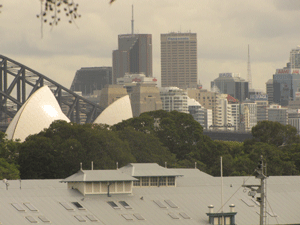
CAIRNS
Yet another flight took us to Cairns, on the northeast coast (distances in Australia are appreciable). With yet another rental car we headed up the Captain Cook Highway to Port Douglas, a resort town an hour away. It was after dark, and though the road was fine, the profusion of roundabouts (traffic circles) was bewildering.
Weather the next morning was balmy, over 90° and rainless. Melbourne, on the other hand, had just endured a monster thunderstorm, with “hailstones bigger than golf balls.” To judge by the televised images of pock-marked cars and wind shields, this time the conventional exaggerated description was really true.
It is easy to spend money in town--for instance, on the “Gecko Splice” cocktail ($15). Our room in the Treetops Resort had a white, beachy feel. The information pamphlet somewhat alarmingly gave instructions for what to do in a cyclone: “Remain calm… Beware the calm eye of the storm; do not leave the room until advised by Management.” We rented a DVD for the room player, but could not get it to work. We called the front desk. “No worries, mate,” we were told. “It’s plugged in, isn’t it? We said that it was. “Just push the a/v button, mate.” We did, without effect. “Maintenance will come ‘round first thing in the morning. No worries” So the next night we got it to play, but the sound track was in an Aboriginal language, so we didn’t understand much.
There is a nearby wildlife center, well worth a $30 visit despite being strangely situated in a shopping mall. Crocs, koalas, tree kangaroos--the whole show. Our main excursion was to the Great Barrier Reef, courtesy Quiksilver Tours. They take you in a bus briefly, then in a speedy boat to a huge pontoon anchored by the reef. This was built in 1994 and accommodates hundreds. There you can slither into your lycra wet suit and snorkel around. The water is astonishingly clear, and full of coral and strange fish. You can get a similar view from a semi-submersible (glass sides), if you are not claustrophobic.
After a few days of resort living, we drove up the coast into the Daintree Forest: “more than 100 million years old and home to the highest number of rare or endangered plant and animal species in the world.” The only trouble with the rain forest was that it was, indeed, raining--even more than usual. We checked into our tropical cabin at the Ferntree Rainforest Lodge, listening to the rain and feeling like characters in a Somerset Maugham story. Most shops and restaurants would not open before the dry season a few weeks away (theoretically). Nor could we head north to Captain Cook’s Cape Tribulation because the roads were flooded. We could have vegetated there a while, but returned to Cairns after one tropical night. Note: local license plates sport the motto, “The Sunshine State.”
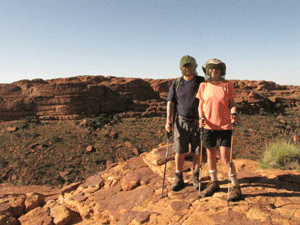
THE NEWSPAPERS
International news was a bit scanty, and we relied on the internet. The papers did devote lots of space to the Israeli use of fake Aussie passports in the Yemen assassination scheme. Also featured: Mr. Shuffles, a zoo elephant that emerged from its mother’s womb after being thought dead for three days. By far the heaviest coverage was given to local cricket captain Michael Clarke and his 22-year-old girlfriend, model Lara Bingle. Seems Lara had posed for too many nude photos, and Michael broke with her. Supposedly--but not, it appears, actually--Lara got angry and flushed her $200,000 engagement ring down the toilet. This saga was front page everywhere.
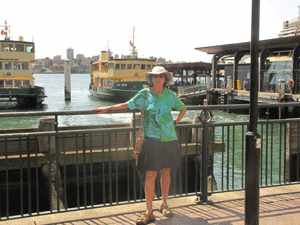
SYDNEY
This was our last stop. We were very grateful to have the hospitality of Susan’s Australian friend, Barbara Rogers, a shibori artist with a lovely home in Paddington, close to downtown. The city is the country’s largest, with about 4.5 million inhabitants. It is very livable; I hope it stays that way when the population grows by one-third, as it is expected to do shortly. The waterfront is a huge harbor, with many small bays and peninsulas. The best-known structure is the great signature scalloped opera house, but many other buildings, new and (relatively) old, and very nice too. Like Melbourne, the city has no subway, but an excellent bus system. We bought a week’s pass for $48 each, so we had to take a lot of buses to get our money’s worth. Happily, the pass is also valid on local ferries.
We had eight days in town, not nearly enough. The first day Barbara drove us up to her family’s beach house, 50 miles north. The ocean and headlands were only a short walk away. Back in town, we went to the expansive botanical gardens, site of a major wine tasting: well over a hundred vineyards from the state (Queensland). $25 bought five coupons, each good for 60 milliliters of wine. After only a few coupons we felt woozy and gave the rest away. The gardens look lovely, even if you are sober. You can skip the trees where the huge bats hang.
Don’t miss the aquarium or the swimming pools.
Of course we went to the opera: Britten’s A Midsummer Night’s Dream, in a very sprightly performance set in colonial India. The house seats about 2500; it is very comfortable, as gloriously situated as photos suggest, and more intimate than the Met. We also saw a play, Stockholm, by Bryony Lavery. Both actors were Australian, as were most of the opera performers.
On our last day, we caught a ferry to the suburb of Manly for a five-mile shore walk. En route we found a swimming area cordoned off against sharks and sting rays. There were toilets and changing rooms, public and free. At the end of the walk, we took a bus back into the city.
Susan wants me to add that the swimming pools are absolutely fabulous.
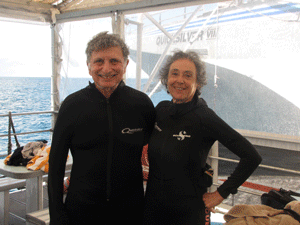
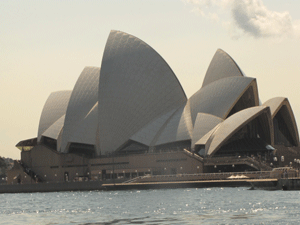 --February-March, 2010
--February-March, 2010